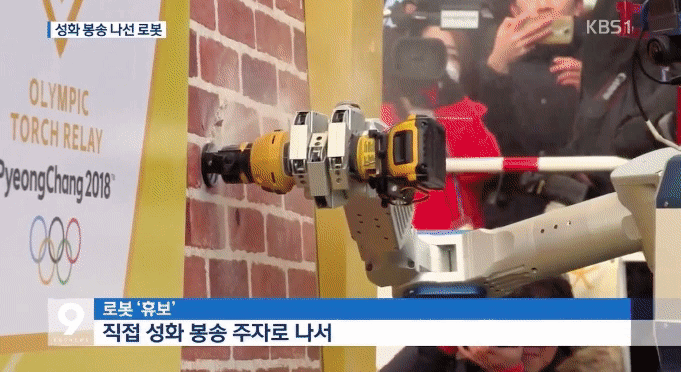On the 41st day of the torch relay of the Korean Pyeongchang Winter Olympics, they sent a special torchbearer, HUBO. It passed the torch in Daejeon, where the Korean Institute of Science and Technology (KAIST) is located.
HUBO is one of the 85 security robots of the Pingchang Winter Olympics. Its height is 47 inches and it can take 65 steps per minute. During the torch relay, it took over the torch from Dennis Hong, founder of the Robotics and Mechanical Laboratory at the University of California, Los Angeles. He walked up to the wall and was supported by staff to reach a painting. Like a brick-clad wooden wall, a hole was drilled with a right-handed drill and the torch held by the left hand was passed on to the next torchbearer, its inventor, Wu Junyu, a professor at the Korea Institute of Science and Technology.
Afterwards, Wu Junxi passed the torch to the FX-2 manned robot. The robot is very large, over 8 feet high and weighing over 600 pounds. Riding a robot is a middle school student who wins a program design competition.
Where is the sacredness behind these two robots?

It is understood that the history of Korean robotics is relatively short compared to other countries. Established in 1971, the Korea Science and Technology Institute is a public research university located in Daejeon, South Korea. Since 2000, it began to study robotics projects and was led by Wu Junyu.
In the Robotics Challenge organized by DARPA (US Defense Advanced Hi-Tech Science and Technology Program) in 2015, HDC-HUBO, one of the KAIST series, won the championship. After the Fukushima nuclear power plant incident, DAPPA decided to hold this competition in hopes of improving the robot's ability to respond to disasters. The final is a combination of semi-autonomous robots and human operations to simulate a disaster scenario and complete a challenging mission. DRC-HUBO won the championship by completing all eight missions as quickly as possible.

In their past research, the most famous is Albert Einstein HUBO - Einstein robot. In 2005, KAIST and robotics company HansonRobotics released the robot at the APEC summit. It is as high as 1.37 meters and weighs 57 kilograms. It has a highly restored Einstein head. HansonRobotics said on the website, "This is the world's first robot to install humanoid heads on live-size walking robots."
David Hansen, founder of HansonRobotics, demonstrated the ability of Einstein robots to understand and imitate facial expressions in their TED talks. He is also helping other scientists understand how robots and humans see emotions and interpret facial expressions. Their idea is that if Einstein robots can develop emotional intelligence, they will help researchers to pave the way for robots to help improve education, healthcare, fine arts, and customer service industries.
It is worth mentioning that the world’s first robotic citizen “Sofiaâ€, who was hot on the Internet some time ago, came from Hanson Robotics. When Sofia was asked in the test, "Do you want to destroy mankind?", her reply "I will destroy mankind" once made people "highly nervous."
Of course, many people are now thinking about whether robots can have emotions, intelligence enough, and even whether they will destroy humans, but we also need to see its advantages in accomplishing certain tasks, just as in the DAPPA competition, in place of humans doing dangerous work. task.
Infrared Pen,Infrared Touch Pen,Infrared Tablet Stylus Pen,Infrared Stylus Pencil
Shenzhen Ruidian Technology CO., Ltd , https://www.wisonen.com